 It was 1967. I was 17 at the time and a big fan of the emerging fast-food craze. McDonald’s was taking off, and we had a place named Sidley’s
It was 1967. I was 17 at the time and a big fan of the emerging fast-food craze. McDonald’s was taking off, and we had a place named Sidley’s  Burger Shack on Marlboro Pike, near the Hillside Drive-in Theater, selling yummy hamburgers for fifteen cents a pop. I loved Fridays because my mother often brought home Sidley’s dinner, which included hamburgers, fries, and shakes. So, I thought the best way to get a constant supply of burgers was to go to work for the new place called Red Barn that had recently opened in Coral Hills. Although the goal was to gorge myself on free eats, I had fallen upon a pretty decent job. Red Barn was a really good chain that was started in the early 60s in Ohio, whose first Franchisee was Harry Barmeier. At its peak, they had around 400 restaurants in 22 states, as well as Canada and Australia. What I liked about Red Barn that was different from McDonald’s, was they sold fried chicken. My mother grew up in Southern Virginia, so fried chicken was one of the foods I learned to love. I still do but have to abstain because of the cholesterol problems we know about now, that we didn’t hear about then.
Burger Shack on Marlboro Pike, near the Hillside Drive-in Theater, selling yummy hamburgers for fifteen cents a pop. I loved Fridays because my mother often brought home Sidley’s dinner, which included hamburgers, fries, and shakes. So, I thought the best way to get a constant supply of burgers was to go to work for the new place called Red Barn that had recently opened in Coral Hills. Although the goal was to gorge myself on free eats, I had fallen upon a pretty decent job. Red Barn was a really good chain that was started in the early 60s in Ohio, whose first Franchisee was Harry Barmeier. At its peak, they had around 400 restaurants in 22 states, as well as Canada and Australia. What I liked about Red Barn that was different from McDonald’s, was they sold fried chicken. My mother grew up in Southern Virginia, so fried chicken was one of the foods I learned to love. I still do but have to abstain because of the cholesterol problems we know about now, that we didn’t hear about then.
I was on the night shift, which went until closing. Our shift manager was a fellow named John. He was all of 19 but was still the boss. John was on his way up the corporate ladder, yet he was very down to earth. We often messed around with him. He drove a dark blue Karmann Ghia that usually started, but sometimes did not. John had a rather weak stomach.

Our blanched French fries were made from scratch, using a potato peeling machine and slicer. We blanched the fries and put them in the cooler for frying when needed. There was a product called Stay Fresh we used to keep them from spoiling. It probably caused health problems, but what the hell did we know in 1967? I couldn’t find anything on the Internet about it, but I would guess it was somehow related to MSG. When Stay Fresh was sprinkled in milk shake mix, it had a foul smell. One of our pranks was to take a bit of shake mix, drop a little Stay Fresh in it, and ask John to take a whiff and let us know if the mix was OK to use. The smell never failed to make him vomit. And we laughed our asses off. Sometimes John would have a drink set aside for himself, and we would add a little Stay Fresh to it when he wasn’t looking. Once he took a sip, he was a goner. It got to the point where we would just tell him it was in his drink (even though it wasn’t) and he would barf. Quite the chuckles for us punks.
My favorite task at Red Barn was to work the grill. Cooking the hamburgers, fries and chicken made me feel like a chef. It kept my Ichabod Craneish persona (picture Ric Ocasek with zits and a paper garrison cap) away from the customers, and I preferred to avoid their whiny orders, anyway. Working the counter usually ticked me off, but running the grill gave me command of the entire process.
The policy of Red Barn was to allow us to have free fried chicken only on Wednesdays and Sundays. But we were cleverer than they thought. At the end of the evening, any leftovers were fair game for our gluttonous ways. Around 10:00 PM, we would drop a load of chicken in the fryer, knowing it couldn’t be sold by the time we closed, leaving us with quite a bit of waste, that either had to be thrown away or consumed. John usually looked the other way, and we had chicken on whatever day we wanted.
Robbery of fast food restaurants was a fairly new phenomenon. During my time at Red Barn, we got hit twice. Once, a guy came in while I was cleaning the grill, hunched down near me to avoid being seen from the window, pointed a gun and yelled, “Where’s the money?” It took me a couple of seconds to realize what was happening, and I just said, “It’s in the back.” He was anxious and ran into the back of the store, while I took a moment to gather myself. Then it dawned on me what was going on. I shook for a while and stood still, then figuring he was gone, went in the back looking for the rest of the crew. No one was around, so I worried a bit, then opened the walk-in refrigerator. Everyone inside instinctively put their hands in the air until they realized it was me, and John asked, “Is he gone?” Since no one was bleeding we figured he was. John then called the police. What the gunman didn’t realize was the cash registers had not been reconciled, so “The money was in them.” Robber Man did get away with the petty cash box, escaping with about $35.00. A big haul, and perhaps a couple of nights of drinking, or one fix of whatever drug he probably abused.

The second attempted heist was just this side of ridiculous. Oftentimes after we closed, our activities included a drive to Guys and Dolls pool hall in Silver Hill, for an early morning round of pocket billiards, or a jaunt to Waldorf to throw our wages away in the slot machines that were legal at the time. This particular evening John was going to drive a few of us to Waldorf. We closed the store, and started piling into his Ghia, when we heard, “Give me the money!” We looked around to see where the voice originated and saw what appeared to be a gun peeking out from the fence behind the store, with the “criminal” hiding in the bushes. The Karmann Ghia wouldn’t start, so we pushed it with John using the driver’s door as a shield, as we backed out of the parking space, snickering all the way. After popping the clutch, the car started, and we drove away from the “bad guy,” and headed to Waldorf. Our subsequent laughter was probably a combination of fear and relief that this particular robbery attempt was committed by a fool. We survived for another day of French fry blanching and terrorizing John.
My stint at Red Barn gives me fond memories. I’m not quite sure what happened with John’s career, but being the kind, gentle soul he was, I would guess he fared well (unless a corporate audit revealed our chicken thievery). I tend to think if people are good, good things come of it. Since I don’t remember his last name, I can’t Google him to see where he might be (just entering John brought about 1,040,000,000 results). But the last Red Barn franchising leases expired around 1986, so I can assume he has left the night shift.

I just hope wherever John is, he has a reliable car.
With Love,
Bake My Fish






 on New Year’s Eve was usually worth an additional $100 – $150 for the night. I was averaging over $1,000 a month, tax free (please don’t tell Uncle Sam), which was a tidy sum back then. It was enough to support my wife and two tots (aged 1 and almost 3), and allowed for the occasional bottle of Boone’s Farm, Bali Hai, Ripple, or a six pack of Black Label. Whenever school was closed for a holiday or snow emergency, I rented a hack and spent the day driving, and studying on the cab stand during slow periods. It was the ultimate temporary profession.
on New Year’s Eve was usually worth an additional $100 – $150 for the night. I was averaging over $1,000 a month, tax free (please don’t tell Uncle Sam), which was a tidy sum back then. It was enough to support my wife and two tots (aged 1 and almost 3), and allowed for the occasional bottle of Boone’s Farm, Bali Hai, Ripple, or a six pack of Black Label. Whenever school was closed for a holiday or snow emergency, I rented a hack and spent the day driving, and studying on the cab stand during slow periods. It was the ultimate temporary profession.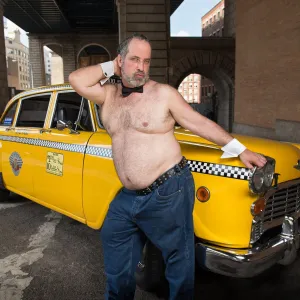 English. But, in defense of today’s cabbies, we weren’t getting constantly mugged and ripped off by passengers, as seems to be so prevalent now. Sure, there was the occasional robbery and the passenger who jumped out without paying, but not to the extent it is today. Those most desperate for work tend to gravitate toward the danger and hassle, because no one else will do it. Cut the drivers a break when criticizing their lack of language skills, if you don’t mind. You’re lucky they are there when you need the ride.
English. But, in defense of today’s cabbies, we weren’t getting constantly mugged and ripped off by passengers, as seems to be so prevalent now. Sure, there was the occasional robbery and the passenger who jumped out without paying, but not to the extent it is today. Those most desperate for work tend to gravitate toward the danger and hassle, because no one else will do it. Cut the drivers a break when criticizing their lack of language skills, if you don’t mind. You’re lucky they are there when you need the ride. Marlow Heights stand, located in front of the Giant Food/
Marlow Heights stand, located in front of the Giant Food/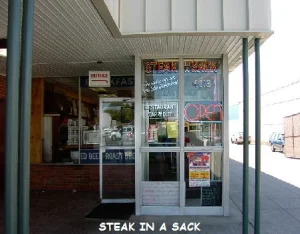 and I’m glad I did. The group met at the Steak in a Sack for a terrific meal that brought back memories of the many sandwiches (basically a steak and cheese in a pita) I ate during my tenure as a cabbie from 1973 – 1976. Chuck was all “retroed-out” in his
and I’m glad I did. The group met at the Steak in a Sack for a terrific meal that brought back memories of the many sandwiches (basically a steak and cheese in a pita) I ate during my tenure as a cabbie from 1973 – 1976. Chuck was all “retroed-out” in his  campus (I was a Maryland student at this point). The reason I liked that location so much was not just because of the great little burgers, but its name. It was called “The Ritz.” Someone had a sense of humor in naming that one.
campus (I was a Maryland student at this point). The reason I liked that location so much was not just because of the great little burgers, but its name. It was called “The Ritz.” Someone had a sense of humor in naming that one.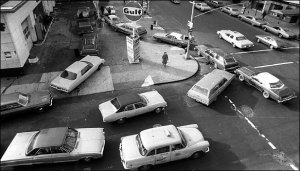 Fine and dandy for them, but my family had to eat and the Oil Embargo was not a welcome addition to my lifestyle. Sitting in line waiting for gas, and running out of gas while waiting, was not a particular thrill. It was irritating. In one instance, I was lucky enough to get a big fare going to Glen
Fine and dandy for them, but my family had to eat and the Oil Embargo was not a welcome addition to my lifestyle. Sitting in line waiting for gas, and running out of gas while waiting, was not a particular thrill. It was irritating. In one instance, I was lucky enough to get a big fare going to Glen  Burnie. The good news was I got a lot of cash for the trip. The bad news was I ended up hitchhiking, holding an empty Clorox container (it was in the trunk in case of an emergency), to get to a station and wait in line, so I could fill up the jug and get back to my taxi, with just enough gas to find another line that I could join and eventually fill up the car. Hitching a ride with long hair and a beard (two more months of growth), wearing jeans, Chucks, and my old Air Force fatigue jacket, isn’t a particularly appealing look to passersby. The addition of the Clorox bottle to my ensemble gave some people the impression I was a bum. My Hippie Wannabe look was transformed into Hobo Chique. It was a killer look, and I don’t mean in the sense of hot and sexy, I mean killer in the sense of homicidal. Fortunately, a real Hippie stopped in his VW bus and drove me around to get the bottle filled and back to my cab. Kindred Spirits. “Peace, Brother. Groovy.”
Burnie. The good news was I got a lot of cash for the trip. The bad news was I ended up hitchhiking, holding an empty Clorox container (it was in the trunk in case of an emergency), to get to a station and wait in line, so I could fill up the jug and get back to my taxi, with just enough gas to find another line that I could join and eventually fill up the car. Hitching a ride with long hair and a beard (two more months of growth), wearing jeans, Chucks, and my old Air Force fatigue jacket, isn’t a particularly appealing look to passersby. The addition of the Clorox bottle to my ensemble gave some people the impression I was a bum. My Hippie Wannabe look was transformed into Hobo Chique. It was a killer look, and I don’t mean in the sense of hot and sexy, I mean killer in the sense of homicidal. Fortunately, a real Hippie stopped in his VW bus and drove me around to get the bottle filled and back to my cab. Kindred Spirits. “Peace, Brother. Groovy.” After the crisis that occurred in ’73, and the subsequent spike in gas prices that resulted, stations began offering the choice of full-service at one price and self-service at a lower cost. Still, many states didn’t allow self-service stations, but as we all know, today they are prevalent everywhere except
After the crisis that occurred in ’73, and the subsequent spike in gas prices that resulted, stations began offering the choice of full-service at one price and self-service at a lower cost. Still, many states didn’t allow self-service stations, but as we all know, today they are prevalent everywhere except  hood” when a job came out. If there was no cab on the stand of a particular section and it went to 1st call, I would make up a location in that section, hoping no other cab could see me. Any time a driver got caught fibbing he was cut off the air for an hour. If I was lucky enough there was no other cab closer to the job, I would get it, which meant I had to hurry, so as not to be discovered. A long delay in picking up a passenger, when I was supposedly nearby, was a dead giveaway. But we could always use the excuse we had a bathroom emergency on the way.
hood” when a job came out. If there was no cab on the stand of a particular section and it went to 1st call, I would make up a location in that section, hoping no other cab could see me. Any time a driver got caught fibbing he was cut off the air for an hour. If I was lucky enough there was no other cab closer to the job, I would get it, which meant I had to hurry, so as not to be discovered. A long delay in picking up a passenger, when I was supposedly nearby, was a dead giveaway. But we could always use the excuse we had a bathroom emergency on the way. privileged enough to accompany the President on Air Force One, most of them flew on the Press plane. And, many of them ordered taxi service to get them into Washington and Northern Virginia once their plane landed. Our dispatcher would give us notification that several cabs would be needed in the Andrews section, so those who wanted the fares would go and sit on The Ramada at the appropriate time in anticipation of a pretty decent trip. The passengers were usually interesting, talkative (after drinking on the plane) and tipped well. I had the pleasure of carrying
privileged enough to accompany the President on Air Force One, most of them flew on the Press plane. And, many of them ordered taxi service to get them into Washington and Northern Virginia once their plane landed. Our dispatcher would give us notification that several cabs would be needed in the Andrews section, so those who wanted the fares would go and sit on The Ramada at the appropriate time in anticipation of a pretty decent trip. The passengers were usually interesting, talkative (after drinking on the plane) and tipped well. I had the pleasure of carrying 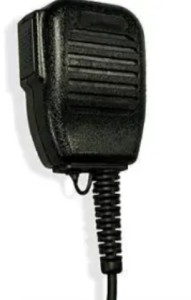 There was a driver whose last name was Abel. I forget his first name because they always just called him Abel. He was a full-time cabbie who worked during the morning hours to make enough money to go to the racetrack in the afternoon and bet on the horses. There were several guys who drove to bet. Then after the races were over, if they lost, they’d come back out on the street and work several hours, or if they won, they would take the rest of the day off. Abel was kind of a cut-up and the dispatchers liked him. My task was to cackle like a chicken over the radio, and I am very good. What was so much fun about the “Chicken Call” was the dispatcher always blamed Abel. My original intention was just to cluck for fun, but when they started yelling at Abel, it became a pretty good game. Sometimes I would continue on until the dispatcher was irritated to the point of threatening to cut Abel off the air. And Abel wasn’t even working. We had different dispatchers at different times, and they always blamed Abel. I got a real chuckle out of it, and it beat studying while sitting on a stand.
There was a driver whose last name was Abel. I forget his first name because they always just called him Abel. He was a full-time cabbie who worked during the morning hours to make enough money to go to the racetrack in the afternoon and bet on the horses. There were several guys who drove to bet. Then after the races were over, if they lost, they’d come back out on the street and work several hours, or if they won, they would take the rest of the day off. Abel was kind of a cut-up and the dispatchers liked him. My task was to cackle like a chicken over the radio, and I am very good. What was so much fun about the “Chicken Call” was the dispatcher always blamed Abel. My original intention was just to cluck for fun, but when they started yelling at Abel, it became a pretty good game. Sometimes I would continue on until the dispatcher was irritated to the point of threatening to cut Abel off the air. And Abel wasn’t even working. We had different dispatchers at different times, and they always blamed Abel. I got a real chuckle out of it, and it beat studying while sitting on a stand. most taxis. I’m not even sure Abel is still alive, but if I were ever to cross his path again, I’d confess to the “Chicken Call,” just to see his expression.
most taxis. I’m not even sure Abel is still alive, but if I were ever to cross his path again, I’d confess to the “Chicken Call,” just to see his expression. In 1968 I was a skinny, pimple-faced High School Senior. My biggest challenges were refraining from squeezing my zits and soiling my undies in my sleep. Worrying about economics, paying bills, who was in charge of the world, or any of those things took a back seat to fantasizing about my Business teacher, Miss Hopkins, and her Tabu perfume, and selling shoes at Bakers in Iverson Mall. But the whole country was going crazy; I just didn’t think about it.
In 1968 I was a skinny, pimple-faced High School Senior. My biggest challenges were refraining from squeezing my zits and soiling my undies in my sleep. Worrying about economics, paying bills, who was in charge of the world, or any of those things took a back seat to fantasizing about my Business teacher, Miss Hopkins, and her Tabu perfume, and selling shoes at Bakers in Iverson Mall. But the whole country was going crazy; I just didn’t think about it. John Kennedy and then won the election by beating a lame opponent, Barry Goldwater. But now he wanted out. The country was being torn apart by opposition to a war that was none of our business. Martin Luther King and Robert Kennedy were assassinated. After the death of MLK, the cities erupted in riots. Whole city
John Kennedy and then won the election by beating a lame opponent, Barry Goldwater. But now he wanted out. The country was being torn apart by opposition to a war that was none of our business. Martin Luther King and Robert Kennedy were assassinated. After the death of MLK, the cities erupted in riots. Whole city  blocks were
blocks were  O. J. Simpson won the Heisman Trophy.
O. J. Simpson won the Heisman Trophy. television reports, while my parents worried I would be drafted. I worried, too. Everyone was expected to wave a flag and declare love for America, but the young people could not figure out why we were in Southeast Asia. We were being thrown to the dogs for the sake of stopping Communist aggression. Or, so the story went. No one wanted to call it a Civil War.
television reports, while my parents worried I would be drafted. I worried, too. Everyone was expected to wave a flag and declare love for America, but the young people could not figure out why we were in Southeast Asia. We were being thrown to the dogs for the sake of stopping Communist aggression. Or, so the story went. No one wanted to call it a Civil War. my tongue, because I understood. No one really wanted to go.
my tongue, because I understood. No one really wanted to go.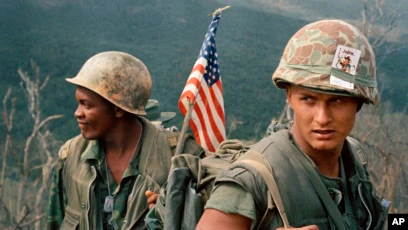 them. They’re safe. You can label me Liberal or whatever, but the fact of the matter is, war kills. It isn’t good for anyone. Everyone suffers.
them. They’re safe. You can label me Liberal or whatever, but the fact of the matter is, war kills. It isn’t good for anyone. Everyone suffers. Charles Manson is well known for his cult following of marauding murderers and sadistic killers. He had a way of convincing some folks to snuff out lives indiscriminately, without conscience. Fortunately, he died on November 19, 2017, so for some sickos, their martyr is gone.
Charles Manson is well known for his cult following of marauding murderers and sadistic killers. He had a way of convincing some folks to snuff out lives indiscriminately, without conscience. Fortunately, he died on November 19, 2017, so for some sickos, their martyr is gone. resurrection from the dead of the executed savior, Jesus Christ? I don’t quite understand the correlation of the two, but I assume when the
resurrection from the dead of the executed savior, Jesus Christ? I don’t quite understand the correlation of the two, but I assume when the  even though those doing the killing and torturing declared they were doing so “in his name.” Was Peter (the rabbit) created as a sort of soothing distraction? Who could blame a cute little bunny, giving away treats, for any indiscretions of the past? I’m sure anyone being tortured during the Spanish Inquisition did not have furry little critters dancing in their heads. They were just a little busy croaking.
even though those doing the killing and torturing declared they were doing so “in his name.” Was Peter (the rabbit) created as a sort of soothing distraction? Who could blame a cute little bunny, giving away treats, for any indiscretions of the past? I’m sure anyone being tortured during the Spanish Inquisition did not have furry little critters dancing in their heads. They were just a little busy croaking.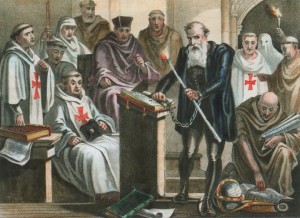 historians the most notorious of them all; quite a blemish on the permanent record of influential distributors of The Word. There is not much mention of it during contemporary sermons. It’s better to forget and let bygones be bygones. After all, those who were involved are no longer available for interviews, and descendants can’t change whatever an ancestor considered appropriate.
historians the most notorious of them all; quite a blemish on the permanent record of influential distributors of The Word. There is not much mention of it during contemporary sermons. It’s better to forget and let bygones be bygones. After all, those who were involved are no longer available for interviews, and descendants can’t change whatever an ancestor considered appropriate.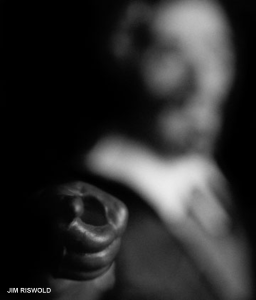 campaign to rid the land of non-believers and establish the Catholic Church as the one true religion.
campaign to rid the land of non-believers and establish the Catholic Church as the one true religion.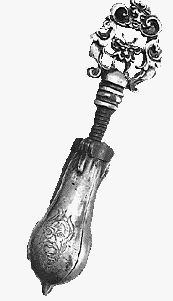 Apparently, the fun part for the Inquisitors was the torture. They developed
Apparently, the fun part for the Inquisitors was the torture. They developed  Heights that always died within a week, and pancake breakfast at the First Baptist Church on 57th Avenue. Then there was fidgeting through the preacher’s talk about Christ and why we celebrate Easter, but all that went over my head because I couldn’t wait to get home to find the hidden eggs. I bet more children overdosed on hard-boiled eggs during that time of year than any other. The eventual
Heights that always died within a week, and pancake breakfast at the First Baptist Church on 57th Avenue. Then there was fidgeting through the preacher’s talk about Christ and why we celebrate Easter, but all that went over my head because I couldn’t wait to get home to find the hidden eggs. I bet more children overdosed on hard-boiled eggs during that time of year than any other. The eventual  flatulence was cause for celebration as each kid tried to out-toot the other. It was a grand time, followed by several days out of school. So, what about Jesus? Lost in the childish celebration of
flatulence was cause for celebration as each kid tried to out-toot the other. It was a grand time, followed by several days out of school. So, what about Jesus? Lost in the childish celebration of 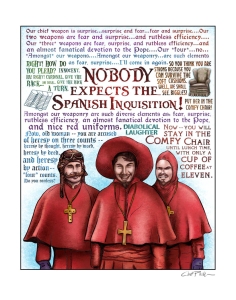 declare all the holidays we want to make it seem better, but it can’t erase the past. Charles Manson should never be forgiven. His victims can’t speak out for themselves. Neither can those who suffered during the Inquisition.
declare all the holidays we want to make it seem better, but it can’t erase the past. Charles Manson should never be forgiven. His victims can’t speak out for themselves. Neither can those who suffered during the Inquisition. Pssst! What’s wrong with this picture? Give up? Well? What? It’s the fraction. I didn’t pay much attention when I was younger, nor have any idea when it began. If you know, tell me, because I am clueless. Now that I’m old and cranky, it just pisses me off!
Pssst! What’s wrong with this picture? Give up? Well? What? It’s the fraction. I didn’t pay much attention when I was younger, nor have any idea when it began. If you know, tell me, because I am clueless. Now that I’m old and cranky, it just pisses me off! purposely pumped 9/10 of a gallon in my car. I usually try to round it off at the .00 mark, occasionally going a penny over (man, it ticks me off when that happens) and then try to go all the way to the next .00. Sometimes I get caught at .77 and can’t fill the tank any more without spilling it on my shoes. My preference is to pay for the fuel in round numbers, not tenths. I rarely have a pocket full of tenthathents.
purposely pumped 9/10 of a gallon in my car. I usually try to round it off at the .00 mark, occasionally going a penny over (man, it ticks me off when that happens) and then try to go all the way to the next .00. Sometimes I get caught at .77 and can’t fill the tank any more without spilling it on my shoes. My preference is to pay for the fuel in round numbers, not tenths. I rarely have a pocket full of tenthathents. 3.23, not 3.24. Many will drive a couple of more miles to buy the gasoline at 3.22 9/10, because it seems like it’s only 3.22. The strategy seems to work. I too, fall prey to their ploy. And to be even sneakier, they don’t use dollar signs (like they’re some fancy restaurant), as if we lemmings won’t know it’s money. Lately, I seem to have stopped chasing down the few-cents-cheaper-gallon-several-blocks-away. It just doesn’t seem worth the fight. I’ll probably burn any savings during the chase down. When gasoline is necessary, I just get it.
3.23, not 3.24. Many will drive a couple of more miles to buy the gasoline at 3.22 9/10, because it seems like it’s only 3.22. The strategy seems to work. I too, fall prey to their ploy. And to be even sneakier, they don’t use dollar signs (like they’re some fancy restaurant), as if we lemmings won’t know it’s money. Lately, I seem to have stopped chasing down the few-cents-cheaper-gallon-several-blocks-away. It just doesn’t seem worth the fight. I’ll probably burn any savings during the chase down. When gasoline is necessary, I just get it.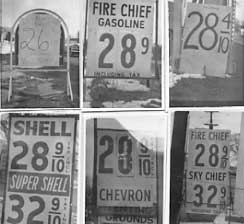 almost as irritating, but for some reason not quite as much as 9/10. Decimals are more appealing than fractions. Fractions seem a bit unwieldy. Decimals are quick and clean. Fractions are like a little fence you have to jump. Decimals are to the point. Hell, they are the point.
almost as irritating, but for some reason not quite as much as 9/10. Decimals are more appealing than fractions. Fractions seem a bit unwieldy. Decimals are quick and clean. Fractions are like a little fence you have to jump. Decimals are to the point. Hell, they are the point.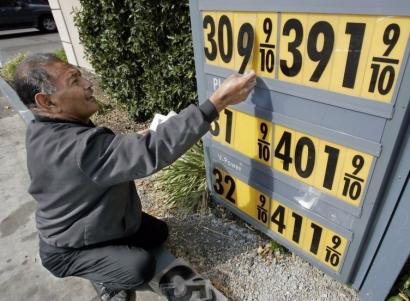 arrived where people are paying more for water than gasoline. Of course, no one can drink 10 gallons of water a day, but we can easily use 10 gallons of gas.
arrived where people are paying more for water than gasoline. Of course, no one can drink 10 gallons of water a day, but we can easily use 10 gallons of gas.
 It is generally accepted that
It is generally accepted that  manager and
manager and  team and Saturdays were anxiously anticipated. I couldn’t wait to get to the lanes for the bowling (but really for the French fries). Bowling Alley fries were the best. That was when they cooked them in real fat, not this sissy trans-fat-less stuff we use today. Grease, salt and ketchup . . . . mmmmm, the best. We were active kids, not slothy adults, so the cholesterol didn’t clog our arteries. In my adult years I bowled with a fellow who drenched his French fries in mustard. If we wanted to snatch a fry or two while he was on the lane bowling, we had to eat them with the yellow stuff. I guess his intent was to thwart our thievery of his snack. It worked. Or maybe he just liked them with mustard. On our team, he was the only one.
team and Saturdays were anxiously anticipated. I couldn’t wait to get to the lanes for the bowling (but really for the French fries). Bowling Alley fries were the best. That was when they cooked them in real fat, not this sissy trans-fat-less stuff we use today. Grease, salt and ketchup . . . . mmmmm, the best. We were active kids, not slothy adults, so the cholesterol didn’t clog our arteries. In my adult years I bowled with a fellow who drenched his French fries in mustard. If we wanted to snatch a fry or two while he was on the lane bowling, we had to eat them with the yellow stuff. I guess his intent was to thwart our thievery of his snack. It worked. Or maybe he just liked them with mustard. On our team, he was the only one. bowled on leagues in Suitland, Forestville (Parkland), Queenstown, Hyattsville (Prince George’s Plaza), Marlow Heights, Catonsville (Westview), Laurel (with mustard guy), Silver Spring (White Oak), Riverdale (Rinaldi), Wheaton (Glenmont), College Park, and probably a couple of places I’ve forgotten.
bowled on leagues in Suitland, Forestville (Parkland), Queenstown, Hyattsville (Prince George’s Plaza), Marlow Heights, Catonsville (Westview), Laurel (with mustard guy), Silver Spring (White Oak), Riverdale (Rinaldi), Wheaton (Glenmont), College Park, and probably a couple of places I’ve forgotten. occurrence. Many ten pin bowlers think they’re “tough guys” because they can roll the heavy ball down the lanes. They ain’t so tough when ending up with two pins for a whole frame because the first ball chopped, and the next two were rolled through the hole. I guess they really don’t appreciate the challenge and precision necessary to be a good duck pinner, so they make fun of it.
occurrence. Many ten pin bowlers think they’re “tough guys” because they can roll the heavy ball down the lanes. They ain’t so tough when ending up with two pins for a whole frame because the first ball chopped, and the next two were rolled through the hole. I guess they really don’t appreciate the challenge and precision necessary to be a good duck pinner, so they make fun of it. The biggest factor in the decline was the demise in 1973 of the only company manufacturing automatic pinsetters (one source says it was 1969).
The biggest factor in the decline was the demise in 1973 of the only company manufacturing automatic pinsetters (one source says it was 1969). due to their willingness to expand and Sherman’s desire to stay at home. His company didn’t survive, and today Fair Lanes establishments are named AMF.
due to their willingness to expand and Sherman’s desire to stay at home. His company didn’t survive, and today Fair Lanes establishments are named AMF. That’s all fine and dandy, but my preferred awards were for Best Team Name and Best Bowling Attire. My favorite team name and attire (designed by my son) is in the picture to the left.
That’s all fine and dandy, but my preferred awards were for Best Team Name and Best Bowling Attire. My favorite team name and attire (designed by my son) is in the picture to the left. like a star. Spend a few minutes clicking on the links (particularly the
like a star. Spend a few minutes clicking on the links (particularly the  Only a few of you might recognize the guy in the picture. His name was
Only a few of you might recognize the guy in the picture. His name was 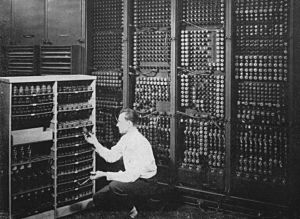 card reader console with several
card reader console with several  used different sing-song inflections and would go on and on into the whole rendition you might observe at a tobacco auction (where as a boy, he developed his fascination). The students loved it. We were all cracking up. Richard really was good.
used different sing-song inflections and would go on and on into the whole rendition you might observe at a tobacco auction (where as a boy, he developed his fascination). The students loved it. We were all cracking up. Richard really was good. There was more to Richard Rose than the hard-working Computer Guy/Auctioneer. When I ran for the
There was more to Richard Rose than the hard-working Computer Guy/Auctioneer. When I ran for the 
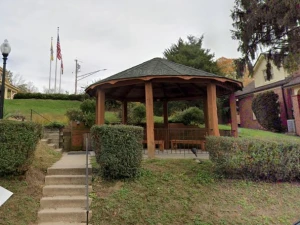 American Heart Association of Carroll County. If you have an auction, who do you call? Richard Rose! He jumped at the opportunity.
American Heart Association of Carroll County. If you have an auction, who do you call? Richard Rose! He jumped at the opportunity. the surge of fast food establishments. In 1955 Ray Kroc opened the first franchise outside Chicago. The original McDonald’s opened in 1940. Many of you probably know the origin and history of the company from The History Channel or Food TV. So, I won’t bore you with the details of when they began and how they have grown. If you are unaware of the history and want to read about it, check out the following link
the surge of fast food establishments. In 1955 Ray Kroc opened the first franchise outside Chicago. The original McDonald’s opened in 1940. Many of you probably know the origin and history of the company from The History Channel or Food TV. So, I won’t bore you with the details of when they began and how they have grown. If you are unaware of the history and want to read about it, check out the following link  heart attacks and diabetes. Now, I don’t know how tall this fellow is, but for him to be considered ideal weight would mean he’d have to be somewhere in the neighborhood of the height of an adolescent oak tree. Did it not dawn on him that he was eating too much and growing in stature? Was the increase in waist size over the years not a hint? Like I said earlier, “Hello . . . . I was a Fat Guy!”
heart attacks and diabetes. Now, I don’t know how tall this fellow is, but for him to be considered ideal weight would mean he’d have to be somewhere in the neighborhood of the height of an adolescent oak tree. Did it not dawn on him that he was eating too much and growing in stature? Was the increase in waist size over the years not a hint? Like I said earlier, “Hello . . . . I was a Fat Guy!” milk shakes. It’s their fault for making stuff people like to eat! We should probably require them to put warnings on the wrappers, “Caution! Eating too much of this can possibly cause obesity, which can lead to high cholesterol, high blood pressure, diabetes and heart attacks!” Duh. I guess it goes along with the other self-inflicted diseases we struggle with these days but blame everyone else for causing. But why waste the print on the warnings? No one will pay attention, even if they are old enough to read. Just buy bigger clothes and help the sweat suit industry (eventually they’ll be sued for making us look frumpy).
milk shakes. It’s their fault for making stuff people like to eat! We should probably require them to put warnings on the wrappers, “Caution! Eating too much of this can possibly cause obesity, which can lead to high cholesterol, high blood pressure, diabetes and heart attacks!” Duh. I guess it goes along with the other self-inflicted diseases we struggle with these days but blame everyone else for causing. But why waste the print on the warnings? No one will pay attention, even if they are old enough to read. Just buy bigger clothes and help the sweat suit industry (eventually they’ll be sued for making us look frumpy). Celebratory salads, celery sticks, tofu, and carrots just aren’t considered festive. But stick a candle in a cake and everybody sings, applauds and gorges. Probably the #1 song in the world is “Happy Birthday.” We all know the words. They even have ridiculous renditions of it at restaurants, sung by the help, clapping their hands in a silly way, while they are delivering the dessert to your table, as you feign embarrassment and surprise.
Celebratory salads, celery sticks, tofu, and carrots just aren’t considered festive. But stick a candle in a cake and everybody sings, applauds and gorges. Probably the #1 song in the world is “Happy Birthday.” We all know the words. They even have ridiculous renditions of it at restaurants, sung by the help, clapping their hands in a silly way, while they are delivering the dessert to your table, as you feign embarrassment and surprise.
 Town Hall has been open since 1960. That’s quite an accomplishment for a drinking spot. Those that come and go are usually “theme” bars catering to whatever fad or style is temporarily occupying the minds of its semi-loyal patrons. Dance clubs seem to last the least amount of time, usually laid waste by fights, drug busts, marriage, and the quick aging and waning interest of its clients. But Town Hall has lasted through student migrations, sporting event-driven traffic, all the
Town Hall has been open since 1960. That’s quite an accomplishment for a drinking spot. Those that come and go are usually “theme” bars catering to whatever fad or style is temporarily occupying the minds of its semi-loyal patrons. Dance clubs seem to last the least amount of time, usually laid waste by fights, drug busts, marriage, and the quick aging and waning interest of its clients. But Town Hall has lasted through student migrations, sporting event-driven traffic, all the  that I only had the nerve to eat once, and an unpretentious atmosphere. It worked.
that I only had the nerve to eat once, and an unpretentious atmosphere. It worked. ny other
ny other  entourage decide to shove off for haute cuisine, laced with over-priced, but oh-so-pretty beverages. Once the children are gone, the Slim Jims and suds taste better.
entourage decide to shove off for haute cuisine, laced with over-priced, but oh-so-pretty beverages. Once the children are gone, the Slim Jims and suds taste better. I was in the neighborhood on business, but beer, pool and peanuts are not on the agenda. When home, I play pinball on my computer, shaking the machine with keystrokes. Diet soda in a can or plastic bottle is my “draft.”
I was in the neighborhood on business, but beer, pool and peanuts are not on the agenda. When home, I play pinball on my computer, shaking the machine with keystrokes. Diet soda in a can or plastic bottle is my “draft.” hungry. Chicken tenders and wings have become old hat, and nachos or chili go in easy and exit violently. What to order? What? Then the hot waitress or waiter you’ve been ogling and hoping may find you appealing, suggests sliders.
hungry. Chicken tenders and wings have become old hat, and nachos or chili go in easy and exit violently. What to order? What? Then the hot waitress or waiter you’ve been ogling and hoping may find you appealing, suggests sliders. taverns and restaurants lately, and now’s your chance to check them out. Hell, even
taverns and restaurants lately, and now’s your chance to check them out. Hell, even 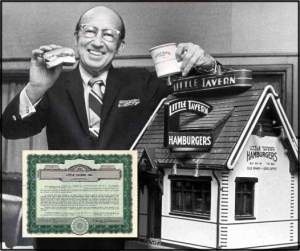 trade. Then in 1928 Harry Duncan relocated from Louisville, KY to Washington, DC and opened the
trade. Then in 1928 Harry Duncan relocated from Louisville, KY to Washington, DC and opened the  were cooked. The “chef” would line the grill with little balls of meat, with chopped onions and fry a bunch, then place them on the small buns along with a pickle and store them covered by a damp towel in a drawer under the grill.
were cooked. The “chef” would line the grill with little balls of meat, with chopped onions and fry a bunch, then place them on the small buns along with a pickle and store them covered by a damp towel in a drawer under the grill. sandwiches that needed to be heated in their toaster ovens (microwaves weren’t available), so my late-night meals were three LT deathballs and a cup of coffee. I’m not one who usually goes for coffee with anything other than breakfast. It just sort of says, “I’m an old fart and don’t care anymore.” Coffee with dinner just doesn’t seem right. But, at Club LT the coffee was delicious, served in the thick mugs that somehow made it better. Not to mention, I needed the caffeine buzz to continue working.
sandwiches that needed to be heated in their toaster ovens (microwaves weren’t available), so my late-night meals were three LT deathballs and a cup of coffee. I’m not one who usually goes for coffee with anything other than breakfast. It just sort of says, “I’m an old fart and don’t care anymore.” Coffee with dinner just doesn’t seem right. But, at Club LT the coffee was delicious, served in the thick mugs that somehow made it better. Not to mention, I needed the caffeine buzz to continue working. driving zone, my favorite cab stand was the College Park Little Tavern, referred to by the cab company as “The Ritz.” Since this location was right across the street from the
driving zone, my favorite cab stand was the College Park Little Tavern, referred to by the cab company as “The Ritz.” Since this location was right across the street from the  , but “Buy ’em by the bag” was the slogan. When Harry started the business, burgers were a nickel, so walking out with a bag full was a pretty easy task. You could feed the whole family.
, but “Buy ’em by the bag” was the slogan. When Harry started the business, burgers were a nickel, so walking out with a bag full was a pretty easy task. You could feed the whole family. living on in its evolved form. The next time you’re at the Green Turtle, Burger King, Chili’s or any place advertising sliders, think of Harry Duncan as you bite into your order. They’re no longer a nickel, and probably not as good, but three deathballs and coffee always hit the spot.
living on in its evolved form. The next time you’re at the Green Turtle, Burger King, Chili’s or any place advertising sliders, think of Harry Duncan as you bite into your order. They’re no longer a nickel, and probably not as good, but three deathballs and coffee always hit the spot. Do you remember the 2008 Burger King
Do you remember the 2008 Burger King 
 absence of it can lead to blood-sucking intruders flying into our homes or accosting us in dark alleys and draining our fluids.
absence of it can lead to blood-sucking intruders flying into our homes or accosting us in dark alleys and draining our fluids. During the 50s men wore hats all the time. It was a part of the business uniform. An insurance salesman coming to your home to sit at the kitchen table and sell you policies usually wore a fedora or maybe a bowler. They were stylish and tasteful. But the guys in the Burger King commercials looked kind of stupid. “Sorry, Mr. Transylvania
During the 50s men wore hats all the time. It was a part of the business uniform. An insurance salesman coming to your home to sit at the kitchen table and sell you policies usually wore a fedora or maybe a bowler. They were stylish and tasteful. But the guys in the Burger King commercials looked kind of stupid. “Sorry, Mr. Transylvania  Man if I am hurting your feelings, but you should rethink your wardrobe.” If there is something festive about the accessory, then maybe you should keep it “under your hat.” I’m afraid seeing you in public will cause me to stare or snicker. It just doesn’t seem worth the comparison of the flame-broiled, 1/4-pound beef patty, with lettuce, mayonnaise, pickles, tomatoes, onions, ketchup on a sesame seed bun to the two all-beef patties, special sauce, lettuce, cheese, pickles, onions on a sesame seed bun.
Man if I am hurting your feelings, but you should rethink your wardrobe.” If there is something festive about the accessory, then maybe you should keep it “under your hat.” I’m afraid seeing you in public will cause me to stare or snicker. It just doesn’t seem worth the comparison of the flame-broiled, 1/4-pound beef patty, with lettuce, mayonnaise, pickles, tomatoes, onions, ketchup on a sesame seed bun to the two all-beef patties, special sauce, lettuce, cheese, pickles, onions on a sesame seed bun. them are used to hide baldness or the lack of shampooing. It’s easier to throw on a cap and ride to the nearest breakfast drive-thru than it is to take a shower and clean the hair. I haven’t noticed anyone in my neighborhood wearing the silly Transylvania hats displayed in the BK commercials. So, “Come on Burger King, show what they really wear.” There is no way they are donning the ridiculous lids portrayed in the
them are used to hide baldness or the lack of shampooing. It’s easier to throw on a cap and ride to the nearest breakfast drive-thru than it is to take a shower and clean the hair. I haven’t noticed anyone in my neighborhood wearing the silly Transylvania hats displayed in the BK commercials. So, “Come on Burger King, show what they really wear.” There is no way they are donning the ridiculous lids portrayed in the  advertisements. If they are, then my appreciation of differing cultures is being challenged, and I will have to laugh with the rest of the world. Those hats were comical.
advertisements. If they are, then my appreciation of differing cultures is being challenged, and I will have to laugh with the rest of the world. Those hats were comical. in some sort of hysterical display, like an Organ Grinder’s Monkey. If you watched the commercials, you know what I mean. It cracked me up every time I saw them, and I wonder if the “actors” felt as silly as they looked. I’m sure they weren’t really Vampires; most likely American Thespians with a Transylvania look, possessing dark, evil eyes.
in some sort of hysterical display, like an Organ Grinder’s Monkey. If you watched the commercials, you know what I mean. It cracked me up every time I saw them, and I wonder if the “actors” felt as silly as they looked. I’m sure they weren’t really Vampires; most likely American Thespians with a Transylvania look, possessing dark, evil eyes. paranoid. But, if I wake up some night and there is a bat in a hat hovering over my bed, I’m gonna dress up like Ronald McDonald, hunt down the Burger King and kick his ass.
paranoid. But, if I wake up some night and there is a bat in a hat hovering over my bed, I’m gonna dress up like Ronald McDonald, hunt down the Burger King and kick his ass. George Bush was recently involved in a game of “Duck, Duck, Goose” during a news conference held in Iraq. One of the members of the Iraqi media (a minivan, with three reporters and two digital cameras) took off his shoes (size 10) and hurled them at the President in an effort to insult him. I am not up on
George Bush was recently involved in a game of “Duck, Duck, Goose” during a news conference held in Iraq. One of the members of the Iraqi media (a minivan, with three reporters and two digital cameras) took off his shoes (size 10) and hurled them at the President in an effort to insult him. I am not up on  were only female and so many times when I was dying fabric pumps in the back room or bringing them to the women, I saw the soles. Not once did I shake or feel insulted. Maybe it was because they were new and had not yet traveled the road of dirty sidewalks or stepped in gum or anything that might make them filthy. My guess is the soiling of the soles of worn shoes is what adds to the insult of showing them to someone. It seems the indignity can only come from a man, since the theory appears to have originated among the not-so-tolerant-of-females men of
were only female and so many times when I was dying fabric pumps in the back room or bringing them to the women, I saw the soles. Not once did I shake or feel insulted. Maybe it was because they were new and had not yet traveled the road of dirty sidewalks or stepped in gum or anything that might make them filthy. My guess is the soiling of the soles of worn shoes is what adds to the insult of showing them to someone. It seems the indignity can only come from a man, since the theory appears to have originated among the not-so-tolerant-of-females men of  the Middle East. That’s probably why I never shivered at Bakers. When Dwight Eisenhower was President, I wonder if Buster Browns were used for the gesture, or would it have been Kinney’s or
the Middle East. That’s probably why I never shivered at Bakers. When Dwight Eisenhower was President, I wonder if Buster Browns were used for the gesture, or would it have been Kinney’s or  some like a man. Typically, men wear pants and have no need to hide their privates. The feminish crosser is most likely just being polite, attempting to avoid showing the sole to innocent observers. It seems to me displaying the bottom of
some like a man. Typically, men wear pants and have no need to hide their privates. The feminish crosser is most likely just being polite, attempting to avoid showing the sole to innocent observers. It seems to me displaying the bottom of  dirty bare feet would be more of a disgusting gesture, but like I said earlier, I’m not a student of the theory. Restaurants do not ban soiled shoe soles, only bare feet. So, the owners of eating establishments must not understand the Shoe Insult Theory, either.
dirty bare feet would be more of a disgusting gesture, but like I said earlier, I’m not a student of the theory. Restaurants do not ban soiled shoe soles, only bare feet. So, the owners of eating establishments must not understand the Shoe Insult Theory, either.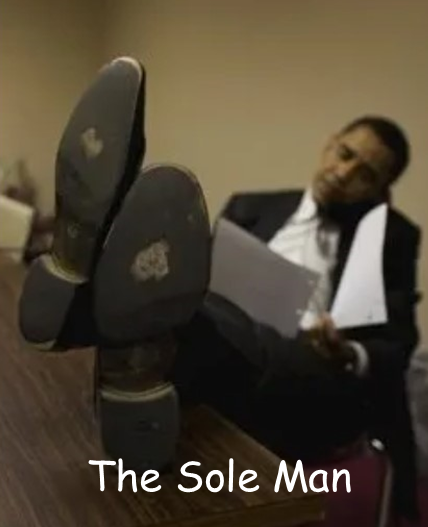 baking process to knead the dough, or is there a subtle insult being extended by the pie? Only the Amish know for sure (but they’re not reading this).
baking process to knead the dough, or is there a subtle insult being extended by the pie? Only the Amish know for sure (but they’re not reading this). I really enjoyed the movie Good Morning, Vietnam. Robin Williams was terrific in his role as
I really enjoyed the movie Good Morning, Vietnam. Robin Williams was terrific in his role as  Vietnam (
Vietnam ( sized trunk, making it possible to smuggle my girlfriend into the
sized trunk, making it possible to smuggle my girlfriend into the  drink at a bar named The End Zone. At the time we only had to be eighteen to qualify for suds in Washington. My drinking partner was a friend, Ronnie Floyd, who had recently been drafted by the Army, but when he went to
drink at a bar named The End Zone. At the time we only had to be eighteen to qualify for suds in Washington. My drinking partner was a friend, Ronnie Floyd, who had recently been drafted by the Army, but when he went to  joked with my parents about wrecking my car. Some joke. After celebrating Ronnie’s imminent tour in Vietnam for a few hours, I said goodbye to him and got in my car for the ride to Landover, where my family was living at the time. Of course, I shouldn’t have been driving, but in those days, no one paid much attention to that sort of thing, so while traveling NE on Alabama Avenue I began to slide in the snow, taking out a police call box. Oopsie Daisy!
joked with my parents about wrecking my car. Some joke. After celebrating Ronnie’s imminent tour in Vietnam for a few hours, I said goodbye to him and got in my car for the ride to Landover, where my family was living at the time. Of course, I shouldn’t have been driving, but in those days, no one paid much attention to that sort of thing, so while traveling NE on Alabama Avenue I began to slide in the snow, taking out a police call box. Oopsie Daisy!  The upper half of the box landed in the back seat of the car, and the lower half was dragged several hundred feet under the vehicle,
The upper half of the box landed in the back seat of the car, and the lower half was dragged several hundred feet under the vehicle, destroying all the hardware necessary for it to operate, as I experienced the twirling sleigh ride from hell, stopping at the corner of Alabama and Massachusetts Avenues. After looking around for Angels or pitchforks and realizing life would continue, I found the nearest pay phone (since the call box was useless) and called my parents.
destroying all the hardware necessary for it to operate, as I experienced the twirling sleigh ride from hell, stopping at the corner of Alabama and Massachusetts Avenues. After looking around for Angels or pitchforks and realizing life would continue, I found the nearest pay phone (since the call box was useless) and called my parents. went to DC and hit the Recruiter’s office. I signed up for the Air Force because it was my best chance not to be wallowing in the mud in ‘Nam. After taking their exam I qualified for several positions and agreed to enlist under the first one available, which was in the administrative category. Whew! I avoided the draft. After Basic Training and Technical School, I was sent to Taiwan. My Radar O’Reilly career was beginning.
went to DC and hit the Recruiter’s office. I signed up for the Air Force because it was my best chance not to be wallowing in the mud in ‘Nam. After taking their exam I qualified for several positions and agreed to enlist under the first one available, which was in the administrative category. Whew! I avoided the draft. After Basic Training and Technical School, I was sent to Taiwan. My Radar O’Reilly career was beginning. The United States maintained a presence in that country following the 1949 fall of China to the Communist regime (Peoples Republic of China) of
The United States maintained a presence in that country following the 1949 fall of China to the Communist regime (Peoples Republic of China) of  beautiful. Imagine a tropical paradise, where you spend most of the day dodging bicycles, scooters, motorcycles, taxis and pedestrians, in overcrowded conditions, and you have a pretty good idea. Taiwan is bisected by the Tropic of Cancer, so the weather in Tainan is similar to Havana, Cuba (without the Castros). I was delighted to be there.
beautiful. Imagine a tropical paradise, where you spend most of the day dodging bicycles, scooters, motorcycles, taxis and pedestrians, in overcrowded conditions, and you have a pretty good idea. Taiwan is bisected by the Tropic of Cancer, so the weather in Tainan is similar to Havana, Cuba (without the Castros). I was delighted to be there. that was deep fried and probably unhealthy, but “Oh so good.” I’m not sure my etiquette was acceptable, but I dipped the bread stick in the soy milk and enjoyed my “Ugly American self.” I was on a four-year vacation and didn’t care what anyone thought.
that was deep fried and probably unhealthy, but “Oh so good.” I’m not sure my etiquette was acceptable, but I dipped the bread stick in the soy milk and enjoyed my “Ugly American self.” I was on a four-year vacation and didn’t care what anyone thought. One of my favorite activities in Taiwan was eating from street vendors (we called them Noodle Stands). As a young, naive kid, I didn’t think there was anything wrong with it and contamination was not a concern. Everything was boiled or deep-fried and just awesome, with just the right sauces and spice. From 1895 to 1945 Taiwan was occupied by the Japanese, influencing the variety of foods. Fried tofu (smelled like feet), squid, snake, various poultry parts, eel, frog, noodles; you name it, I ate it. I’m sure today, based on my recent experience with
One of my favorite activities in Taiwan was eating from street vendors (we called them Noodle Stands). As a young, naive kid, I didn’t think there was anything wrong with it and contamination was not a concern. Everything was boiled or deep-fried and just awesome, with just the right sauces and spice. From 1895 to 1945 Taiwan was occupied by the Japanese, influencing the variety of foods. Fried tofu (smelled like feet), squid, snake, various poultry parts, eel, frog, noodles; you name it, I ate it. I’m sure today, based on my recent experience with  Tainan Air Base was situated next to Air Asia (Air America- CIA), and our job was basically to keep the Communist Chinese from overtaking the island and providing support for activities in Vietnam. For me, it was renting a house off base for less than $40 a month and partying with my friends. In the Communications Center we manned an old switchboard, probably left over from the
Tainan Air Base was situated next to Air Asia (Air America- CIA), and our job was basically to keep the Communist Chinese from overtaking the island and providing support for activities in Vietnam. For me, it was renting a house off base for less than $40 a month and partying with my friends. In the Communications Center we manned an old switchboard, probably left over from the  Korean War (thus the Radar reference). Within the “secret” area we operated a General Dynamics computer that was a combination teletype, card reader, magnetic tape reader, and printer, very high tech for the time. In the building next door, there was the radio station, American Forces Network Taiwan, which was the only station in southern Taiwan to broadcast in English. If you open this
Korean War (thus the Radar reference). Within the “secret” area we operated a General Dynamics computer that was a combination teletype, card reader, magnetic tape reader, and printer, very high tech for the time. In the building next door, there was the radio station, American Forces Network Taiwan, which was the only station in southern Taiwan to broadcast in English. If you open this  Chinese Air Force Academy in
Chinese Air Force Academy in  The Chinese like to eat. Their parties consist of many dishes on the table, where everyone partakes, family-style. But the officers, particularly the General in charge of the school, liked Johnny Walker Black; however, they did not sip the beverage, they swilled. Every time a drink was poured one of them would shout “Gambei!” and we would all tilt our heads back and shoot the beverage down our gullets. After several “down the hatches” the food and drink were not sitting so well. Eventually, it was time to grab the toilet bowl with both hands, on my knees, and rid myself of the evening’s offerings. In the adjacent stall of the men’s room, it was obvious someone was experiencing the same ordeal. I exited my area for clean up, and guess who came out of the other stall to do the same? The General. He smiled, then laughed and patted me on the back, while slurring something in Chinese. Apparently, I had made a friend. Who would have thought Johnny Walker was such a matchmaker?
The Chinese like to eat. Their parties consist of many dishes on the table, where everyone partakes, family-style. But the officers, particularly the General in charge of the school, liked Johnny Walker Black; however, they did not sip the beverage, they swilled. Every time a drink was poured one of them would shout “Gambei!” and we would all tilt our heads back and shoot the beverage down our gullets. After several “down the hatches” the food and drink were not sitting so well. Eventually, it was time to grab the toilet bowl with both hands, on my knees, and rid myself of the evening’s offerings. In the adjacent stall of the men’s room, it was obvious someone was experiencing the same ordeal. I exited my area for clean up, and guess who came out of the other stall to do the same? The General. He smiled, then laughed and patted me on the back, while slurring something in Chinese. Apparently, I had made a friend. Who would have thought Johnny Walker was such a matchmaker? interested in auditioning for a part-time position as a weekend broadcaster. It was volunteer work but would be a lot of fun. I jumped at the opportunity and as soon as my shift was over, stopped by to meet with the Station Manager. He gave me a script to read, I passed the test, and “poof” I was given the job. My show was Saturday
interested in auditioning for a part-time position as a weekend broadcaster. It was volunteer work but would be a lot of fun. I jumped at the opportunity and as soon as my shift was over, stopped by to meet with the Station Manager. He gave me a script to read, I passed the test, and “poof” I was given the job. My show was Saturday morning at 6:00 AM, in between Wolf Man Jack and Bob Kinglsey (both on tape), and Sunday at 8:00, right after a religious show (yeah, they were probably politically incorrect, but no one complained). From March 1972 through February 1973, I was a small-time star.
morning at 6:00 AM, in between Wolf Man Jack and Bob Kinglsey (both on tape), and Sunday at 8:00, right after a religious show (yeah, they were probably politically incorrect, but no one complained). From March 1972 through February 1973, I was a small-time star. known as the Young Rascals). During every show, a young girl would call and ask to hear
known as the Young Rascals). During every show, a young girl would call and ask to hear  The Stooges (which had to be smuggled into the studio because they didn’t have anything commercially acceptable), Dr. John, and Humble Pie. I was having a blast, playing air guitar and banging pencils on the console like a wannabe drummer. Then the phone rang. It was the Station Manager. “You know, Bob, we have people stationed here with varying musical tastes. We are the only English Language station in Southern Taiwan; therefore, our people might want to hear something they like, rather than just what you like. So, could you mix it up somewhat and refrain from playing just the hard stuff at 8:00 in the morning?” That’s all he said, but I got his point and grabbed some Frank Sinatra, Johnny Cash, and Stevie Wonder from the library. My morning became a little more boring for me, but the job was secure.
The Stooges (which had to be smuggled into the studio because they didn’t have anything commercially acceptable), Dr. John, and Humble Pie. I was having a blast, playing air guitar and banging pencils on the console like a wannabe drummer. Then the phone rang. It was the Station Manager. “You know, Bob, we have people stationed here with varying musical tastes. We are the only English Language station in Southern Taiwan; therefore, our people might want to hear something they like, rather than just what you like. So, could you mix it up somewhat and refrain from playing just the hard stuff at 8:00 in the morning?” That’s all he said, but I got his point and grabbed some Frank Sinatra, Johnny Cash, and Stevie Wonder from the library. My morning became a little more boring for me, but the job was secure.
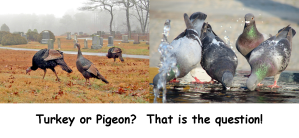 Suppose the Pilgrims decided to have pigeon for dinner instead of turkey; how would we be different? The common pigeon is everywhere, crapping on everything. What if it was a turkey? The load would be greater and statues would deteriorate at a much faster pace. Turkeys are beautiful, pigeons are “Eh.” But, if pigeons were celebrated like turkeys, where would we be?
Suppose the Pilgrims decided to have pigeon for dinner instead of turkey; how would we be different? The common pigeon is everywhere, crapping on everything. What if it was a turkey? The load would be greater and statues would deteriorate at a much faster pace. Turkeys are beautiful, pigeons are “Eh.” But, if pigeons were celebrated like turkeys, where would we be? about cranberry sauce? Would the vile condiment be as good with pigeon? I hate it anyway, but those who like it might be put off. There would be more wish bones for the kids, but smaller legs for the fathers. Carving would be quicker for Dad, too.
about cranberry sauce? Would the vile condiment be as good with pigeon? I hate it anyway, but those who like it might be put off. There would be more wish bones for the kids, but smaller legs for the fathers. Carving would be quicker for Dad, too. “gobble,” what would
“gobble,” what would  more room for turkeys, and there would be a danger of letting the birds loose from the roofs. They could very well fall upon some unsuspecting passersby. Old men on fixed incomes, sitting on park benches, would have to spend more to feed turkeys.
more room for turkeys, and there would be a danger of letting the birds loose from the roofs. They could very well fall upon some unsuspecting passersby. Old men on fixed incomes, sitting on park benches, would have to spend more to feed turkeys. really don’t eat much squab. I don’t recall seeing it on a menu recently. But, it is considered a delicacy. I would have a tough time with a squab leg being deposited on my plate with a message tied to it. Kind of like a fortune cookie. When I pass a pigeon on the street, I don’t think of food. If that pigeon were a turkey, a homeless person could eat for a week. I’m not sure they are eating pigeon, but a turkey would be hard to resist.
really don’t eat much squab. I don’t recall seeing it on a menu recently. But, it is considered a delicacy. I would have a tough time with a squab leg being deposited on my plate with a message tied to it. Kind of like a fortune cookie. When I pass a pigeon on the street, I don’t think of food. If that pigeon were a turkey, a homeless person could eat for a week. I’m not sure they are eating pigeon, but a turkey would be hard to resist. be busy enjoying stuffing, mashed potatoes, cranberry sauce, sweet potatoes, pumpkin pie, beer, wine and liquor. I doubt any of us will be considering pigeon. But, if the Pilgrims chose the bird we take for granted and consider more of a pest than a morsel, pigeon would be the featured dish.
be busy enjoying stuffing, mashed potatoes, cranberry sauce, sweet potatoes, pumpkin pie, beer, wine and liquor. I doubt any of us will be considering pigeon. But, if the Pilgrims chose the bird we take for granted and consider more of a pest than a morsel, pigeon would be the featured dish.